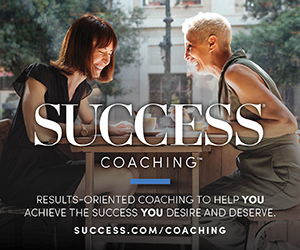You’ve probably heard the reassuring saying that when one door closes, another one opens. Author, executive coach and positive psychology expert Stella Grizont says she hopes her story demonstrates that “you don’t have to actually shut the door. You might be perfectly where you need to be and [may only need to] adjust something within.”
That mindset shift of embracing the detours and seeing setbacks as “setups” encapsulates key aspects of The Work Happiness Method, which is also the title of Grizont’s new book.
Grizont describes going through her own existential crisis, crying in bathrooms at work, suffering from imposter syndrome and feeling unfulfilled—even after completing a master’s degree in happiness (applied positive psychology) and launching her own business.
“Then something clicked,” she recalls. “I realized I was the common denominator. I realized maybe it wasn’t the corporate clients who weren’t creative enough. Maybe it wasn’t the leadership at the startup. Maybe it’s me.”
That realization was the genesis for what is now a thriving coaching program, reaching more than 100,000 people through talks in more than 40 countries. In her book, Grizont describes the process and tools she uses to guide people on a personal journey to find happiness at work.
She focuses on work because it’s where we spend most of our waking hours, and it can be “the best sandpaper for our growth,” but you can apply her method to any facet of life.
“I’m grateful that my path led me to this,” she says. “I’m just trying to help people avoid the anguish and existential crisis that I had.” Here, Grizont explains the eight inner skills she coaches to help steer people toward growth—and enjoy the process.
Stella Grizont’s “Work Happiness Method”
1. Resilience
“Being able to manage your mind and mood when you hit setbacks” is a crucial skill, Grizont says. “Our moods determine how much we see and how much we take in,” she adds, citing the importance of abstaining from a negative mindset. “If you want to see new possibilities for yourself, it’s most likely going to happen when you’re feeling safe and you’re in a positive state of mind.” This doesn’t mean ignoring what’s wrong, but rather acknowledging it and giving yourself space and compassion to cultivate possibility where you can.
2. Clarity
The Work Happiness Method offers guidance and tools to make these subtle shifts. One of those is defining your vision—“your unique definition of success.” Grizont explains, “that’s a description of who you are when you’re most alive.” It’s not a to-do list of goals, “it’s about how are you feeling, and who are you being and what are those conditions that support you?”
3. Purpose
“If our vision is our destination, our values are the guardrails that keep us in the right lane,” Grizont says. “They influence our decisions on a daily basis.” She notes that it can be a process to establish your own values, as opposed to those you inherited from your parents or adapted from others. Grizont walks people through a step-by-step process to clarify those values. “There’s no guesswork. I want people to feel like they’re guided.”

4. Boundaries
Focusing on your vision and living your values can involve setting boundaries, which Grizont envisions as space to grow within. “It’s a focus on, ‘what do I want to hold, expand and create within myself?’ versus putting on armor and protecting myself from the bad stuff.” Grizont leads clients on what she calls an “energy audit” to discover and set boundaries. “You need to understand what parts of your job… or what activities you find energizing or draining, so that you can do something about it.”
5. Play
Stella Grizont is a big believer in play, especially its utility in regulating and reframing life’s uncertainties. “We’re wired for it as humans,” she says. “It changes the way our brain works. It increases neuroplasticity. It helps us face ever-changing landscapes.” Playfulness allows us to “create just a little bit of space for the unexpected—and even unexpected delight or learning or growth.”
6. Discovery
“When you’re playful, then you can be open. And actually, you’re in discovery mode.” At the end of each chapter of The Work Happiness Method, Grizont offers an assignment. “Discovery is about what changes, if any, do I need to make in my role, in my responsibilities? Or what can I add or what do I want to steer myself toward, if anything?” She calls people “discovery tourists” when they set out to “job craft”—gathering information and considering new paths or customizing existing roles and relationships.
7. Approach
Making changes can involve difficult conversations. Grizont advises preparing for and engaging in fruitful conversations while avoiding confrontations. “The opportunity here, if mastered, is that you will not only get what you need but also get more,” she writes in her book. “You get to grow.” That’s because approach “is really an inner process,” she says. “Oftentimes the most difficult conversation you have to have is with yourself first.”
8. Refocus
In her book, Grizont writes about “yielding to life,” staying curious and getting aligned with “our best self, the version we describe in our vision.” Refocusing helps you “befriend the detours” and “creatively leverage the inner skills you’ve been practicing.” It’s coming full circle and putting all eight skills to use.
Grizont says she’s seen significant results in terms of increased happiness and satisfaction in individuals and organizations employing her method. “Success isn’t necessarily about what you achieve,” Grizont says. “It’s about who you’re being.”
This article originally appeared in the March issue of SUCCESS+ digital magazine. Photo courtesy of Stella Grizont.



